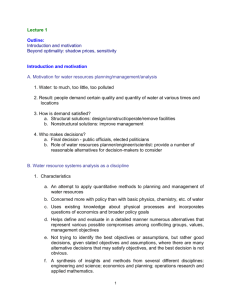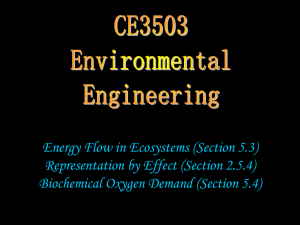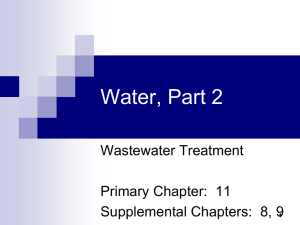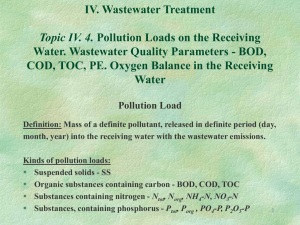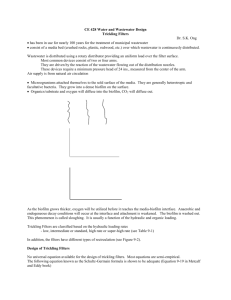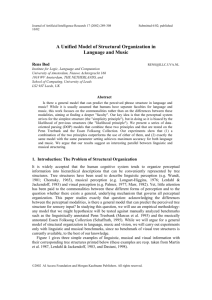LEC-11 - wec civilians
advertisement
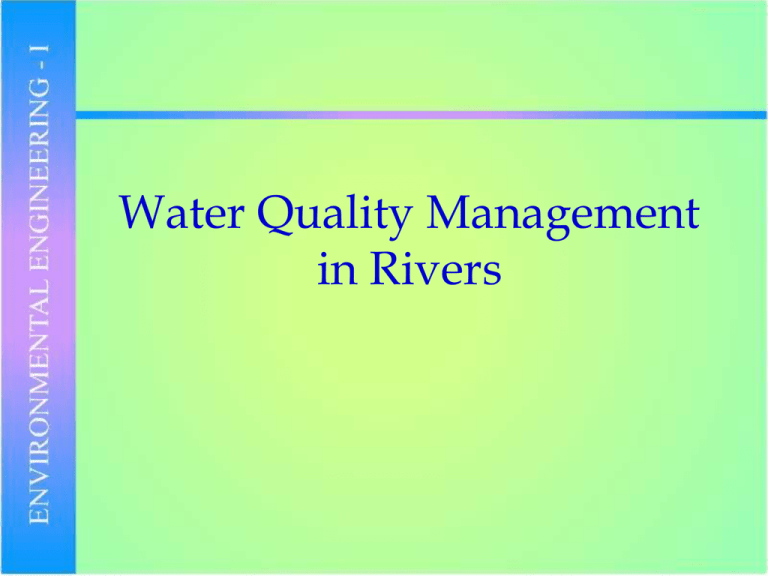
Water Quality Management in Rivers Dissolved Oxygen Depletion Dissolved Oxygen Depletion Biochemical Oxygen Demand Measurement • Take sample of waste; dilute with oxygen saturated water; add nutrients and microorganisms (seed) • Measure dissolved oxygen (DO) levels over 5 days • Temperature 20° C • In dark (prevents algae from growing) • Final DO concentration must be > 2 mg/L • Need at least 2 mg/L change in DO over 5 days Example • A BOD test was conducted in the laboratory using wastewater being dumped into a Lake. The samples are prepared by adding 3.00 mL of wastewater to the 300.0 mL BOD bottles. The bottles are filled to capacity with seeded dilution water. Example : Raw Data Time (days) 0 1 2 3 4 5 Diluted Blank Seeded sample Sample DO DO (mg/L) (mg/L) 7.95 8.15 3.75 8.10 3.45 8.05 2.75 8.00 2.15 7.95 1.80 7.90 Example : Calculations • What is the BOD5 of the sample? [(DO i DO f ) - (B i B f )(1 P)] BODm P P dilution factor volume sample/ total volume B i , B f initial and final DO concentrations of the seeded diluted water (blank) DOi , DO f initial and final DO concentrations of the diluted sample • Plot the BOD with respect to time. Example : Time – Concentration Plot 700 600 BOD (mg/L) 500 400 300 200 100 0 0 1 2 3 time (days) 4 5 6 Conc. (mg/L) Modeling BOD as a First-order Reaction 6 5 4 3 2 1 0 Organic matter oxidized Organic matter remaining 0 10 20 time (days) 30 Modeling BOD Reactions • Assume rate of decomposition of organic waste is proportional to the waste that is left in the flask. dLt - kLt dt where Lt amountof oxygendemandleft aft er t imet k t heBOD rat econst ant(t ime-1 ) Solving t hisequat ion yields : Lt Lo e kt where Lo is t heult imat ecarbonaceous oxygendemand Conc. (mg/L) Ultimate BOD 6L 5o 4 3 2 1 0 Lo- Lt BOD exerted BODt L L remaining t 0 10 20 time (days) 30 Ultimate Biochemical Oxygen Demand Lt = amount of O2 demand left in sample at time, t Lo = amount of O2 demand left initially (at time 0, no DO demand has been exerted, so BOD = 0) At any time, Lo = BODt + Lt (that is the amount of DO demand used up and the amount of DO that could be used up eventually) Assuming that DO depletion is first order BODt = Lo(1 - e-kt) Example • If the BOD5 of a waste is 102 mg/L and the BOD20 (corresponds to the ultimate BOD) is 158 mg/L, what is k? BODt L0 1 e kt BOD t 1 e kt L0 BOD t ln 1 L 0 kt Example (cont) BOD t ln1 L0 k t 102mg/L ln1 158mg/L k 5 day k 0.21 day -1 Biological Oxygen Demand: Temperature Dependence • Temperature dependence of biochemical oxygen demand As temperature increases, metabolism increases, utilization of DO also increases kt = k20T-20 = 1.135 if T is between 4 - 20 oC = 1.056 if T is between 20 - 30 oC Example The BOD rate constant, k, was determined empirically to be 0.20 days-1 at 20 oC. What is k if the temperature of the water increases to 25 oC? What is k if the temperature of the water decreases to 10 oC? Example k25 0.20 day (1.056) -1 k25 0.26 day -1 1020 k10 0.20 day (1.135) -1 2520 k10 0.056day -1 Nitrogenous Oxygen Demand • So far we have dealt only with carbonaceous demand (demand to oxidize carbon compounds) • Many other compounds, such as proteins, consume oxygen • Mechanism of reactions are different Nitrogenous Oxygen Demand • Nitrification (2 step process) 2 NH3 + 3O2 2 NO2- + 2H+ + 2H2O 2 NO2- + O2 2 NO3– Overall reaction: NH3 + 2O2 NO3- + H+ + H2O • Theoretical NBOD = grams of oxygen used 4 x 16 4.57 g O 2 /g N grams of nitrogen oxidized 14 Nitrogenous Oxygen Demand Nitrogenous oxygen demand • Untreated domestic wastewater ultimate-CBOD = 250 - 350 mg/L ultimate-NBOD = 70 - 230 mg/L Total Kjeldahl Nitrogen (TKN) = total concentration of organic and ammonia nitrogen in wastewater: 15 - 50 mg/L as N Ultimate NBOD 4.57 x TKN Other Measures of Oxygen Demand Chemical Oxygen Demand • Chemical oxygen demand - similar to BOD but is determined by using a strong oxidizing agent to break down chemical (rather than bacteria) • Still determines the equivalent amount of oxygen that would be consumed • Value usually about 1.25 times BOD Water Quality Management in Rivers Dissolved Oxygen Depletion Dissolved Oxygen Sag Curve Mass Balance Approach • Originally developed by H.W. Streeter and E.B. Phelps in 1925 • River described as “plug-flow reactor” • Mass balance is simplified by selection of system boundaries • Oxygen is depleted by BOD exertion • Oxygen is gained through re-aeration Steps in Developing the DO Sag Curve 1. Determine the initial conditions 2. Determine the re-aeration rate from stream geometry 3. Determine the de-oxygenation rate from BOD test and stream geometry 4. Calculate the DO deficit as a function of time 5. Calculate the time and deficit at the critical point Selecting System Boundaries Initial Mixing Qw = waste flow (m3/s) DOw = DO in waste (mg/L) Lw = BOD in waste (mg/L) Qr = river flow (m3/s) DOr = DO in river (mg/L) Lr = BOD in river (mg/L) Qmix = combined flow (m3/s) DO = mixed DO (mg/L) La = mixed BOD (mg/L) 1. Determine Initial Conditions a. Initial dissolved oxygen concentration Qw DOw Qr DOr DO Qw Qr b. Initial dissolved oxygen deficit D DOs DO where D = DO deficit (mg/L) DOs = saturation DO conc. (mg/L) Qw DOw Qr DOr Da DOs Qmix 1. Determine Initial Conditions c. DOsat is a function of temperature. Values can be found in Table. Initial ultimate BOD concentration Qw Lw Qr Lr La Qw Qr 2. Determine Re-aeration Rate a. O’Connor-Dobbins correlation 3.9u1/ 2 kr h3 / 2 where kr = reaeration coefficient @ 20ºC (day-1) u = average stream velocity (m/s) h = average stream depth (m) b. Correct rate coefficient for stream temperature T 20 kr kr ,20 where Θ = 1.024 Determine the De-oxygenation Rate a. rate of de-oxygenation = kdLt where kd = de-oxygenation rate coefficient (day-1) Lt = ultimate BOD remaining at time (of travel downstream) t b. If kd (stream) = k (BOD test) Lt L0e and kd t rate of deoxygentation kd L0ekd t 3. Determine the De-oxygenation Rate c. However, k = kd only for deep, slow moving streams. For others, u kd k h where η = bed activity coefficient (0.1 – 0.6) d. Correct for temperature T 20 kr kr ,20 where Θ = 1.135 (4-20ºC) or 1.056 (20-30ºC) 4. DO as function of time • Mass balance on moving element dD k d Lt k r D dt • Solution is kd La kd t kr t Dt e e Da e kr t kr kd 5. Calculate Critical time and DO kr k r k d 1 tc ln 1 Da kr kd kd k d La kd La kd tc kr tc k r tc Dc e e Da e kr ka


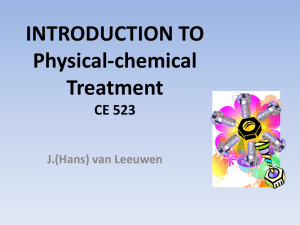

![Crisis Communication[1] - NorthSky Nonprofit Network](http://s2.studylib.net/store/data/005428035_1-f9c5506cadfb4c60d93c8edcbd9d55bf-300x300.png)
